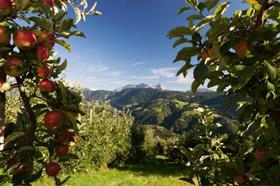
In Italy, Vog has reported on a positive start to the 2019/20 campaign, with the apple market expected to stabilise after last year's issues.
The 2017/2018 season ended early due to a lack of supply, while 2018/2019 was an extremely challenging year that saw prices collapse in autumn after a very plentiful European harvest.
However, things are set to normalise in the coming year, according to Vog chief executive Gerhard Dichgans.
'If forecasts for 2019 are confirmed and a reduction of 40 per cent of Poland’s production materialises we will return to a year of stability,” he confirmed. “The new harvest in South Tyrol promises to be of good quality, with volumes in line with the past season, albeit – unfortunately – with smaller sizes.'
Forecast
As Dichgans pointed out, estimates for the European apple harvest, which were presented at the start of August at Prognosfruit in Belgium, showed a reverse from the 2018/19 campaign.
With an estimated harvest of 10.5m tonnes, there is a 2.7m tonne drop (-20 per cent) compared with 2018’s apple harvest. This is mainly down to the scarce crop in Poland, which was hit by heavy frosts during.
Forecasts in the production zones of France, Spain and Italy show an increased but still average harvest, although with small- to medium-sizes. Finally, in Germany the estimate of a 15 per cent fall following an exceptional harvest year, even in private gardens, is little surprise.
“10.5m tonnes in Europe has always represented something of a dividing line, and suggests that apple supplies are returning to levels of consumer demand,' Dichgans continued. 'Unfortunately, calibres are lower than average as a direct result of an overly cold spring followed by prolonged drought and heat over the summer.
'Therefore, there will be a lack of larger sizes with an abundance of small to medium sizes,' he said. 'This will be apparent early on in the market, and we will see a very wide price range between individual sizes.
'Some doubts remain,” Dichgans commented, “on the true size of the crop in Poland which, on its own, accounts for almost 25 per cent of the European total. However, advance prices already starting to rise for apples to be used in manufacturing is an early sign that something serious has taken place.”
South Tyrol
For its member cooperatives, the consortium is forecasting an apple harvest of 525,000 tonnes, practically the same amount of apples as 2018, but significantly less than the record year of 2016, when over 600,000 tonnes of apples were harvested.
“If we look at estimates by variety, Gala is the top variety in terms of volume, with a forecast of 125,000 tonnes, up 15 per cent on the last season where we lost significant volumes as a result of hailstorms,' Dichgans explained.
'Golden Delicious is down again, showing a drop of more than 10 per cent at 105,000 tonnes. Red Delicious, Braeburn and Granny Smith are close to last season’s volumes. And finally Fuji is back to a good yield – after a season of alternate bearing – showing an increase of 30 per cent.”
Prospects for club varieties are good, with increases for Pink Lady, and Kanzi and a major surge for the still young Envy, with volumes up 30 per cent to almost 3,800 tonnes thanks to new plantings coming online.
Organic apple volumes are also on the rise, estimated at 25,000 tonnes, due partly to new producers who have completed the three-year conversion period.
Among the flagship organic varieties, Royal Gala, Braeburn, Pinova/Evelina and Cripps Pink/Pink Lady stand out, according to Vog.
Looking ahead, a further 300ha of organic planted area will be added to the current 650ha under organic production, to reach a total of approximately 1,000ha within three years.
“A sore point as the new campaign begins will be stocks of Italian Golden from the previous harvest, which are still significant, overlapping with the upcoming new harvest of fresh apples,” Dichgans pointed out. “There is already demand for new-season Gala apples and I foresee a lively start to the commercial season.
'On the other hand, a below-average European harvest guarantees a balance between supply and demand and gives hope to our producers who expect a return to profitability. With the harvest having started now, the next 15 weeks will be crucial: respect for harvesting timeframes for each variety and microclimate will be key to success, and to bring into coldstorage a product at the right stage of ripeness and with good shelf life. Our producers are fully aware of this.
“I am convinced,” Dichgans added, “that the new season can develop positively and cancel out the disappointing results of the last year.'



